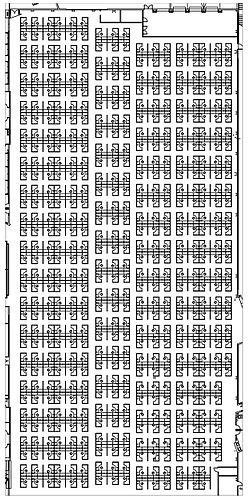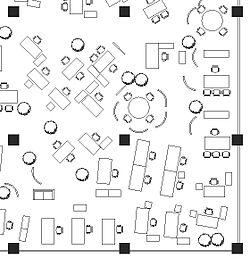Open plan
This article may lend undue weight to certain ideas, incidents, or controversies. (November 2013) |



Open plan is the generic term used in architectural and interior design for any floor plan which makes use of large, open spaces and minimizes the use of small, enclosed rooms such as private offices. The term can also refer to landscaping of housing estates, business parks, etc., in which there are no defined property boundaries such as hedges, fences or walls. In residential design, open plan or open concept (the term used mainly in Canada[1]) describes the elimination of barriers such as walls and doors that traditionally separated distinct functional areas, such as kitchen, living room, and dining room.
Open plan offices
Development of open plan workspace types
Prior to the 1950s, open plan offices mostly consisted of large regular rows of desks or benches where clerks, typists, or technicians performed repetitive tasks.[2] Such designs were rooted in the work of industrial engineers or efficiency experts such as Frederick Winslow Taylor and Henry Ford. In the 1950s, a German team named Quickborner developed office landscape which used conventional furniture, curved screens, large potted plants, and organic geometry to create work groups on large, open floors. Office landscape was quickly supplanted by office furniture companies which developed cubicles based on panel-hung or systems furniture. Many different terms (mostly derisive) have been used over time for offices using the old-style, large arrays of open cubicles including 'sea of cubicles' and 'cube farms'. Frank Lloyd Wright was the first architect to use the 'open plan' design in houses.
An increase in knowledge work and the emergence of mobile technology during the late 20th Century has led to an evolution in open plan offices.[3][4] Many different companies are experimenting with designs which provide a mix of cubicles, open workstations, private offices, and group workstations. In some cases, these are not assigned to one particular individual, but are available to any employee of the company on either a reservable or "drop-in" (first come, first served) basis. Terms for this strategy include office hotelling and alternative officing.[5]
Types of open plan workplace
- Team-oriented ‘bullpen’ – employees can see and hear each other freely, but desks are grouped into teams. Michael Bloomberg used this set-up and term at his media company Bloomberg L.P. and for his staff while Mayor of New York City.[6]
- High-panelled cubicles – employees can’t see other employees when seated.
- Low-panelled cubicles – employees can see over the panels when seated.
- Clusters or ‘pods’ – a group of low-panelled work stations, separated by high panels from other pods.
See also cubicle.
Advantages and disadvantages
A systematic survey of research upon the effects of open plan offices found frequent negative effects in some traditional workplaces: high levels of noise, stress, conflict, high blood pressure and a high staff turnover.[7] The noise level greatly reduces the productivity, which drops to one third relative to what it would be in quiet rooms.[8] Open plan offices have frequently been found to reduce the confidential or private conversations employee engage in, reduce job satisfaction, concentration and performance, whilst increasing auditory and visual distractions.[4][9]
Neither open or closed plan offices are perfect for any one situation or individual. The right balance is required. any office design is likely to involve trade-offs for the workers, with some positives and negatives.[9]
Architect Frank Duffy developed a taxonomy to classify the form of office space that would suit different types of workers.[2] How much interaction individuals require, the work design (i.e., the amount of job autonomy), together with the information technology available, predict the office design that may best suit the worker.
In general:
- Age profiles are essential to determining the suitability of open plan offices. Generally, the older the employee, the more privacy they prefer[citation needed].
- Most people prefer closed offices[citation needed].
- Flexibility is increased when the office is open plan – as the company grows and changes, seating can grow to suit.
- Open plan costs less per capita.
A balance between the office types may be found by employees having an open setting with part-time access to a quiet workspace. While there is a dearth of studies confirming positive impacts on productivity from open plan office designs, a recent study by the Queensland University of Technology, Australia has confirmed the adverse effects. Tom de Marco and Timothy Lister, established this as early as 1987 in their work 'Peopleware'.
Open planning in schools
Openconcept schools were introduced in the 1950s and 60s in order to reduce the clutter of hallways, and increase the size of classrooms. Notable openconcept schools in Canada include Marc Garneau Collegiate Institute and William Berczy Public School.
References
- ^ http://dictionary.reference.com/browse/open-concept Definition of openconcept
- ^ a b Duffy, F. (1997). The new office. London Conran Octopus
- ^ Gillen, N. M. (2006). The Future Workplace, Opportunities, Realities and Myths: A Practical Approach to Creating Meaningful Environments. In J. Worthington (Ed.), Reinventing the Workplace (2nd ed., pp. 61 - 78). Oxford: Architectural Press.
- ^ a b Davis, M. C., Leach, D. J., & Clegg, C. W. (2011). The Physical Environment of the Office: Contemporary and Emerging Issues. In G. P. Hodgkinson & J. K. Ford (Eds.), International Review of Industrial and Organizational Psychology (Vol. 26, pp. 193 - 235). Chichester, UK: Wiley. http://dx.doi.org/10.1002/9781119992592.ch6
- ^ Cornell study
- ^ Nagourney, Adam. "Bloomberg Vows to Work at Center of Things", New York Times
- ^ Dr Vinesh Oommen (13 Jan 2009), Why your office could be making you sick, Asia-Pacific Journal of Health Management
- ^ Julian Treasure TED talk: The 4 ways sound affects us
- ^ a b Elsbach, K. D., & Pratt, M. G. (2007). Chapter 4: The Physical Environment in Organizations. The Academy of Management Annals, 1(1), 181 - 224.
